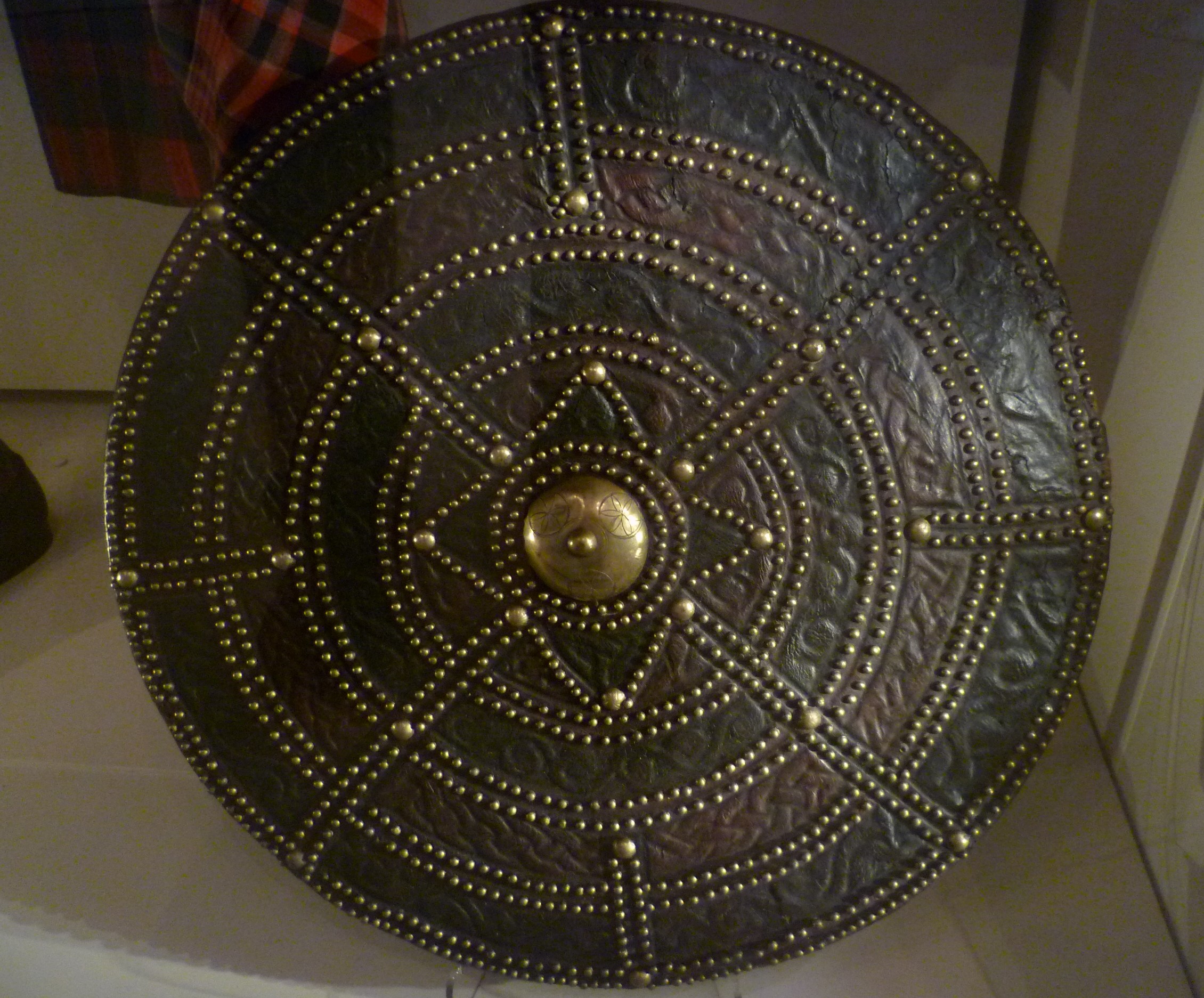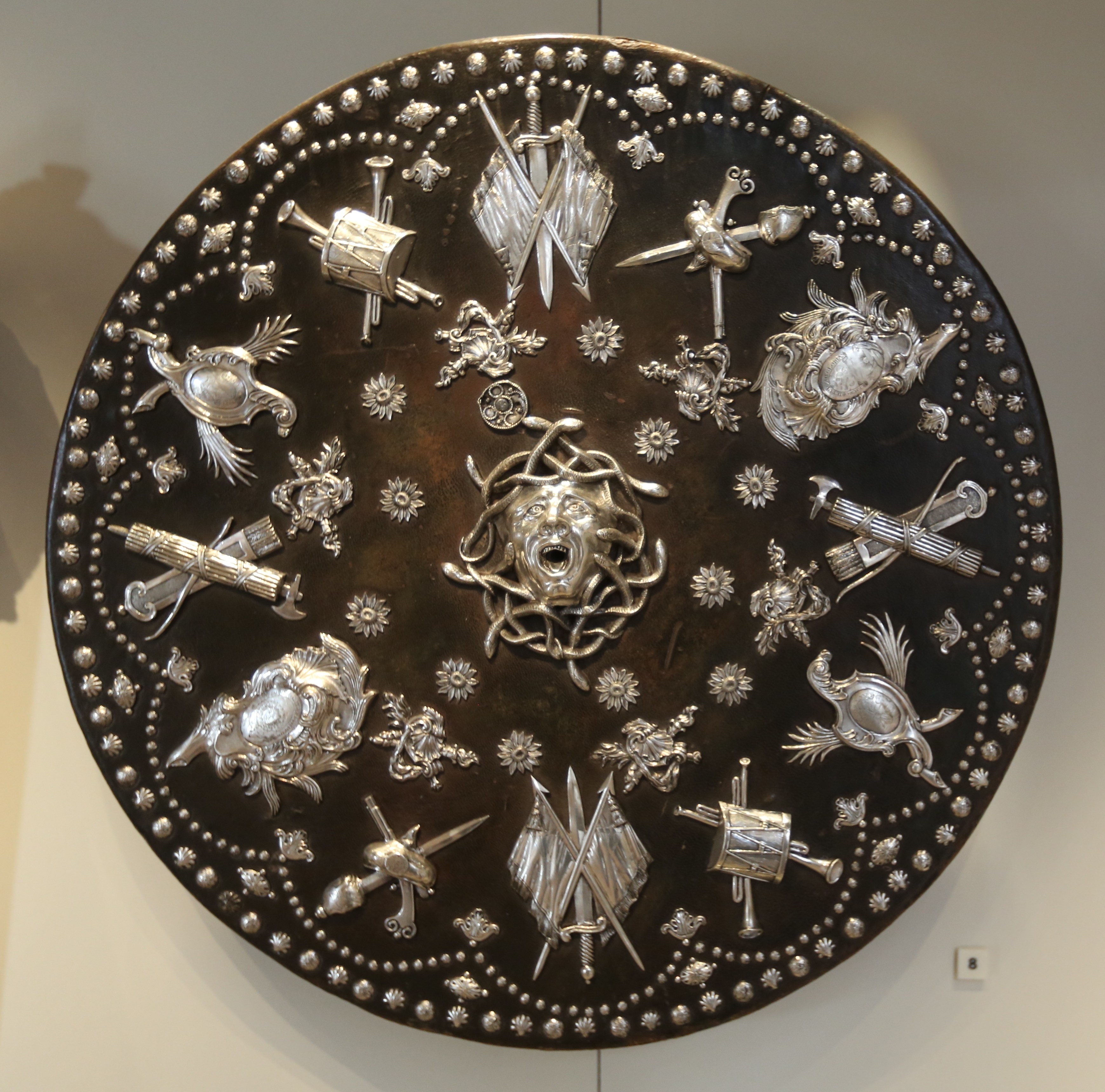Targe on:
[Wikipedia]
[Google]
[Amazon]
 Targe (from Old Franconian ' 'shield',
Targe (from Old Franconian ' 'shield',

 Targes are generally
Targes are generally
Highland targes of the seventeenth and eighteenth centuries
log-in required Medieval shields Military of Scotland
 Targe (from Old Franconian ' 'shield',
Targe (from Old Franconian ' 'shield', Proto-Germanic
Proto-Germanic (abbreviated PGmc; also called Common Germanic) is the reconstructed proto-language of the Germanic branch of the Indo-European languages.
Proto-Germanic eventually developed from pre-Proto-Germanic into three Germanic branc ...
' 'border') was a general word for shield
A shield is a piece of personal armour held in the hand, which may or may not be strapped to the wrist or forearm. Shields are used to intercept specific attacks, whether from close-ranged weaponry or projectiles such as arrows, by means of a ...
in late Old English
Old English (, ), or Anglo-Saxon, is the earliest recorded form of the English language, spoken in England and southern and eastern Scotland in the early Middle Ages. It was brought to Great Britain by Anglo-Saxon settlement of Britain, Anglo ...
. Its diminutive, ''target'', came to mean an object to be aimed at in the 18th century.
The term refers to various types of shields used by infantry troops from the 13th to 16th centuries, or earlier. More specifically, a targe was a concave shield fitted with enarmes
Enarmes are the leather gripping straps attached to the back of shields throughout the Medieval period.
Enarmes were held in place by riveting through the leather and the facing of the shield, and reinforced with small, square-cut washers. Enarm ...
on the inside, one adjustable by a buckle, to be attached to the forearm, and the other fixed as a grip for the left hand. These shields were mostly made of iron or iron-plated wood. From the 15th century, the term could also refer to special shields used for jousting
Jousting is a martial game or hastilude between two horse riders wielding lances with blunted tips, often as part of a tournament (medieval), tournament. The primary aim was to replicate a clash of heavy cavalry, with each participant trying t ...
. A fair number were created wholly for show.
From the late 16th century, until the Battle of Culloden in 1746, the Scottish Highlander's main means of defence in battle was his targe. In February 1596 the clan leader John Grant of Freuchie was able to muster 500 men including 40 armed "according to the Highland custom" with bows, helmets, swords, and targes. After the disastrous defeat of the Jacobites
Jacobite means follower of Jacob or James. Jacobite may refer to:
Religion
* Jacobites, followers of Saint Jacob Baradaeus (died 578). Churches in the Jacobite tradition and sometimes called Jacobite include:
** Syriac Orthodox Church, sometime ...
at Culloden, the carrying of the targe had been banned by the Disarming Act
The Disarming Act (1 George 1 session 2 C.26) was an 18th-century Act of Parliament of Great Britain that was enacted to curtail Jacobitism among the Scottish clans in the Scottish Highlands after the Jacobite rising of 1715. The new law, which ca ...
, and many were destroyed, or put to other uses. Those that remain have intricate patterns, and are decorated, indicating that they would have originally belonged to important people.
Structure of the Scottish targe
 Targes are generally
Targes are generally round shield
A round shield can refer to any type of hand-held shield that has a round shape. They come in highly varying sizes, and have, in different forms, been very popular in Europe, the Asia and the Americas, throughout the Bronze Age, the Classical per ...
s between 18 in and 21 in (45–55 cm) in diameter. The inside of the targe was formed from two very thin layers of flat wooden boards, with the grain
A grain is a small, hard, dry fruit (caryopsis) – with or without an attached hull layer – harvested for human or animal consumption. A grain crop is a grain-producing plant. The two main types of commercial grain crops are cereals and legum ...
of each layer at right angles to the other. They were fixed together with small wooden pegs, forming plywood. The front was covered with a tough cowhide, which was often decorated with embossed Celtic style patterns. This was fixed to the wood with many brass, or in some cases, silver, nails, and occasionally brass plates were also fixed to the face for strength and decoration. Targes generally had center bosses of brass. A Highlander was usually armed with a broadsword
The basket-hilted sword is a sword type of the early modern era characterised by a basket-shaped guard that protects the hand. The basket hilt is a development of the quillons added to swords' crossguards since the Late Middle Ages.
In m ...
or dagger in one hand and targe on his other arm for close combat. It was also common for a dirk to be held in the targe hand, with the blade extending below the targe.
The back of the targe was commonly covered in deerskin, and a very few had some packing of straw etc. behind this. Some targes, usually those actually used in battle, had their backs covered in a piece of red cloth taken from the uniform of a British soldier (a "Redcoat") that the owner had killed in battle. Although all the old targes show signs of handles and arm straps, of various designs including centre-grips, there is very little evidence to indicate that there was any guige
A guige ( /ɡiːʒ/, /ɡiːd͡ʒ/) is a long strap, typically made of leather, used to hang a shield
A shield is a piece of personal armour held in the hand, which may or may not be strapped to the wrist or forearm. Shields are used to ...
strap for carrying the targe over the shoulder.{{Citation needed, date=December 2022
See also
*Buckler
A buckler (French ''bouclier'' 'shield', from Old French ''bocle, boucle'' 'boss') is a small shield, up to 45 cm (up to 18 in) in diameter, gripped in the fist with a central handle behind the boss. While being used in Europe since ant ...
References
External links
Highland targes of the seventeenth and eighteenth centuries
log-in required Medieval shields Military of Scotland